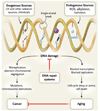Solid tumor second primary neoplasms: who is at risk, what can we do?
- PMID: 24331190
- PMCID: PMC3921623
- DOI: 10.1053/j.seminoncol.2013.09.012
Solid tumor second primary neoplasms: who is at risk, what can we do?
Abstract
Eighteen percent of incident malignancies in the United States are a second (or subsequent) cancer. Second primary neoplasms (SPNs), particularly solid tumors, are a major cause of mortality and serious morbidity among cancer survivors successfully cured of their first cancer. Multiple etiologies may lead to a cancer survivor subsequently being diagnosed with an SPN, including radiotherapy for the first cancer, unhealthy lifestyle behaviors, genetic factors, aging, or an interaction between any of these factors. In this article, we discuss these factors and synthesize this information for use in clinical practice, including preventive strategies and screening recommendations for SPNs.
© 2013 Elsevier Inc. All rights reserved.
Figures





Similar articles
-
Secondary neoplasms following treatment for brain tumors.Cancer Treat Res. 2009;150:239-73. doi: 10.1007/b109924_16. Cancer Treat Res. 2009. PMID: 19834673 Review. No abstract available.
-
Radiation therapy in Hodgkin disease: why risk a Pyrrhic victory?J Natl Cancer Inst. 2005 Oct 5;97(19):1394-5. doi: 10.1093/jnci/dji310. J Natl Cancer Inst. 2005. PMID: 16204683 No abstract available.
-
Cumulative absolute breast cancer risk for young women treated for Hodgkin lymphoma.J Natl Cancer Inst. 2005 Oct 5;97(19):1428-37. doi: 10.1093/jnci/dji290. J Natl Cancer Inst. 2005. PMID: 16204692
-
Radiation-associated breast cancer after Hodgkin's disease: risks and screening in perspective.J Clin Oncol. 1992 Nov;10(11):1662-5. doi: 10.1200/JCO.1992.10.11.1662. J Clin Oncol. 1992. PMID: 1403048 No abstract available.
-
[Secondary cancers: Incidence, risk factors and recommendations].Bull Cancer. 2015 Jul-Aug;102(7-8):656-64. doi: 10.1016/j.bulcan.2015.03.011. Epub 2015 Apr 23. Bull Cancer. 2015. PMID: 25911942 Review. French.
Cited by
-
Risk of colorectal cancer among long-term cervical cancer survivors.Med Oncol. 2014 May;31(5):943. doi: 10.1007/s12032-014-0943-2. Epub 2014 Apr 3. Med Oncol. 2014. PMID: 24696219
-
Metachronous triple primary neoplasms with primary prostate cancer, lung cancer, and colon cancer: A case report.Medicine (Baltimore). 2018 Jun;97(26):e11332. doi: 10.1097/MD.0000000000011332. Medicine (Baltimore). 2018. PMID: 29953024 Free PMC article.
-
Review of risk factors of secondary cancers among cancer survivors.Br J Radiol. 2019 Jan;92(1093):20180390. doi: 10.1259/bjr.20180390. Epub 2018 Sep 12. Br J Radiol. 2019. PMID: 30102558 Free PMC article. Review.
-
Radiation-induced malignancies after intensity-modulated versus conventional mediastinal radiotherapy in a small animal model.Sci Rep. 2019 Oct 29;9(1):15489. doi: 10.1038/s41598-019-51735-3. Sci Rep. 2019. PMID: 31664066 Free PMC article.
-
Coexisting and Second Primary Cancers in Patients with Uveal Melanoma: A 10-Year Nationwide Database Analysis.J Clin Med. 2021 Oct 15;10(20):4744. doi: 10.3390/jcm10204744. J Clin Med. 2021. PMID: 34682867 Free PMC article.
References
-
- Howlader N, Noone AM, Krapcho M, Garshell J, Neyman N, Altekruse SF, Kosary CL, Yu M, Ruhl J, Tatalovich Z, Cho H, Mariotto A, Lewis DR, Chen HS, Feuer EJ, Cronin KA, editors. SEER Cancer Statistics Review. Bethesda, MD: National Cancer Institute; 1975–2010. http://seer.cancer.gov/csr/1975_2010/, based on November 2012 SEER data submission, posted to the SEER web site, April 2013.
-
- Travis LB, Bhatia S, Allan JM, Oeffinger KC, Ng A. Second Primary Cancers. In: Devita VT Jr, Lawrence TS, Rosenberg SA, editors. Cancer: Principles and Practice of Oncology. 9th edition. Philadelphia, PA: Lippincott Williams & Wilkins; 2011.
-
- Hutchison GB. Late neoplastic changes following medical irradiation. Cancer. 1976;37:1102–1110. - PubMed
-
- Dores GM, Metayer C, Curtis RE, Lynch CF, Clarke EA, Glimelius B, et al. Second malignant neoplasms among long-term survivors of Hodgkin's disease: a populationbased evaluation over 25 years. J Clin Oncol. 2002;20:3484–3494. - PubMed
-
- Bhatia S, Robison LL, Oberlin O, Greenberg M, Bunin G, Fossati-Bellani F, et al. Breast cancer and other second neoplasms after childhood Hodgkin's disease. N Engl J Med. 1996;334:745–751. - PubMed
Publication types
MeSH terms
Substances
Grants and funding
LinkOut - more resources
Full Text Sources
Other Literature Sources
Medical

